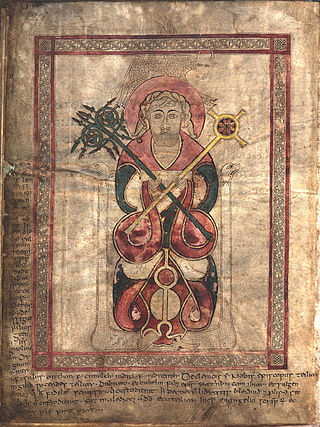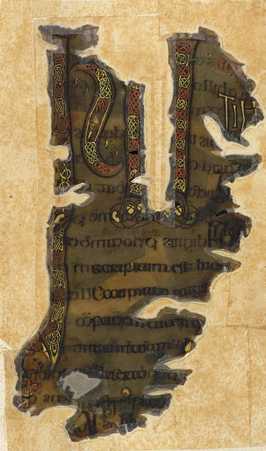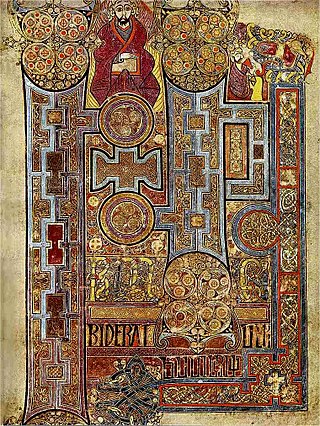
The Lindisfarne Gospels is an illuminated manuscript gospel book probably produced around the years 715–720 in the monastery at Lindisfarne, off the coast of Northumberland, which is now in the British Library in London. The manuscript is one of the finest works in the unique style of Hiberno-Saxon or Insular art, combining Mediterranean, Anglo-Saxon and Celtic elements.

The Book of Kells is an illuminated manuscript and Celtic Gospel book in Latin, containing the four Gospels of the New Testament together with various prefatory texts and tables. It was created in a Columban monastery in either Ireland or Scotland, and may have had contributions from various Columban institutions from each of these areas. It is believed to have been created c. 800 AD. The text of the Gospels is largely drawn from the Vulgate, although it also includes several passages drawn from the earlier versions of the Bible known as the Vetus Latina. It is regarded as a masterwork of Western calligraphy and the pinnacle of Insular illumination. The manuscript takes its name from the Abbey of Kells, County Meath, which was its home for centuries.

Scriptorium, literally "a place for writing", is commonly used to refer to a room in medieval European monasteries devoted to the writing, copying and illuminating of manuscripts commonly handled by monastic scribes.

The Lichfield Gospels is an 8th-century Insular Gospel Book housed in Lichfield Cathedral. There are 236 surviving pages, eight of which are illuminated. Another four contain framed text. The pages measure 30.8 cm by 23.5 cm. The manuscript is also important because it includes, as marginalia, some of the earliest known examples of written Old Welsh, dating to the early part of the 8th century. The art historian Peter Lord dates the book at 730, placing it chronologically before the Book of Kells but after the Lindisfarne Gospels.

Echternach is a commune with town status in the canton of Echternach, which is part of the district of Grevenmacher, in eastern Luxembourg. Echternach lies near the border with Germany, and is the oldest town in Luxembourg.

The Barberini Gospels is an illuminated Hiberno-Saxon manuscript Gospel Book, assumed to be of a late 8th-century origin.

The Durham Gospels is a very incomplete late 7th-century insular Gospel Book, now kept in the Durham Cathedral Dean and Chapter Library. A single folio of this manuscript is now in Magdalene College, Cambridge. Only two of the fully decorated pages survive: a Crucifixion and the initial to John, and both of these are in poor condition. There were probably originally evangelist portraits and carpet pages, as in other Insular Gospel books conceived on a similar scale. The book was produced at Lindisfarne and brought to Durham when the monks of Lindisfarne removed to Durham because of Viking attacks. The Durham Gospels were written by the same scribe who wrote the Echternach Gospels, now in Paris.

The Echternach Gospels were produced, presumably, at Lindisfarne Abbey in Northumbria around the year 690. This location was very significant for the production of Insular manuscripts, such as the Durham Gospels and the Lindisfarne Gospels. The scribe of the Durham Gospels is believed to have created the Echternach Gospels as well. The Echternach Gospels are now in the collection of France's Bibliothèque Nationale in Paris.

Insular script is a medieval script system originating from Ireland that spread to England and continental Europe under the influence of Irish Christianity. Irish missionaries took the script to continental Europe, where they founded monasteries such as Bobbio. The scripts were also used in monasteries like Fulda, which were influenced by English missionaries. They are associated with Insular art, of which most surviving examples are illuminated manuscripts. It greatly influenced modern Gaelic type and handwriting.

Ottonian art is a style in pre-romanesque German art, covering also some works from the Low Countries, northern Italy and eastern France. It was named by the art historian Hubert Janitschek after the Ottonian dynasty which ruled Germany and Northern Italy between 919 and 1024 under the kings Henry I, Otto I, Otto II, Otto III and Henry II. With Ottonian architecture, it is a key component of the Ottonian Renaissance. However, the style neither began nor ended to neatly coincide with the rule of the dynasty. It emerged some decades into their rule and persisted past the Ottonian emperors into the reigns of the early Salian dynasty, which lacks an artistic "style label" of its own. In the traditional scheme of art history, Ottonian art follows Carolingian art and precedes Romanesque art, though the transitions at both ends of the period are gradual rather than sudden. Like the former and unlike the latter, it was very largely a style restricted to a few of the small cities of the period, and important monasteries, as well as the court circles of the emperor and his leading vassals.

The Otho-Corpus Gospels is a badly damaged and fragmentary 8th century illuminated manuscript. It was part of the Cotton library and was mostly burnt in the 1731 fire at Ashburnham House. The manuscript now survives as charred fragments in the British Library. Thirty six pages of the manuscript were not in the Cotton collection and survived the fire. They are now in the library of Corpus Christi College, Cambridge.

Insular art, also known as Hiberno-Saxon art, was produced in the post-Roman era of Great Britain and Ireland. The term derives from insula, the Latin term for "island"; in this period Britain and Ireland shared a largely common style different from that of the rest of Europe. Art historians usually group Insular art as part of the Migration Period art movement as well as Early Medieval Western art, and it is the combination of these two traditions that gives the style its special character.
The eighth-century Codex Eyckensis is a Gospel Book based on two constituent manuscripts that were bound as a single codex from (presumably) the twelfth century until 1988. The Codex Eyckensis is the oldest book in Belgium. Since the eighth century it has been kept and preserved on the territory of the present-day municipality of Maaseik, in Belgium. The book was probably produced in the scriptorium in the Abbey of Echternach. It is housed in the church of St Catherine in Maaseik.
Merovingian illumination is the term for the continental Frankish style of illumination in the late seventh and eight centuries, named for the Merovingian dynasty. Ornamental in form, the style consists of initials constructed from lines and circles based on Late Antique illumination, title pages with arcades and crucifixes. Figural images were almost totally absent. From the eight century, zoomorphic decoration began to appear and become so dominant that in some manuscripts from Chelles whole pages are made up of letters formed from animals. Unlike the contemporary Insular illumination with its rampant decoration, the Merovingian style aims for a clean page.

Insular illumination refers to the production of illuminated manuscripts in the monasteries of Ireland and Great Britain between the 6th and 9th centuries, as well as in monasteries under their influence on continental Europe. It is characterised by decoration strongly influenced by metalwork, the constant use of interlacing, and the importance assigned to calligraphy. The most celebrated books of this sort are largely gospel books. Around sixty manuscripts are known from this period.
The Sainte-Chapelle Gospels or the Sainte-Chapelle Gospel Book is an Ottonian illuminated manuscript now housed in the Bibliothèque nationale de France in Paris as Latin 8851. It is made up of 156 parchment folios, in a 38.5 cm by 28 cm format, making it one of the largest manuscripts of its era. It includes miniatures such as the canon tables, Christ in majesty and the Four Evangelists. It is the work of the Master of the Registrum Gregorii, the most famous illuminator of the Ottonian Renaissance.
The Gregorian Sacramentary is a 10th-century illuminated Latin manuscript containing a sacramentary. Since the 16th century it has been in the Vatican Library, shelfmark Vat. Lat. 3806.

The Gundohinus Gospels is an illuminated Gospel Book of 754–755 named after its scribe Gundohinus. It contains one of the earliest figures in a Frankish manuscript and is now in the town library in Autun. It is often held as an example of the new Frankish-papal alliance's opposition to Byzantine iconoclasm.

The Emperor's Bible, also known as Codex Caesareus, Codex Caesareus Upsaliensis or the Goslar Gospels, is an 11th-century illuminated manuscript currently in Uppsala University Library, Sweden. Despite its name, it is not a Bible but a Gospel Book. The book was made in the scriptorium of Echternach Abbey, and is one of four preserved large Gospel Books made there during the 11th century. It was commissioned by Emperor Henry III and donated by him to Goslar Cathedral, where it remained until the Thirty Years' War. It was then lost for about 100 years. Its previous richly decorated cover was also lost at this time at the latest. The book later appeared again in the possession of Swedish diplomat and civil servant Gustaf Celsing the Elder. At the death of his son, it was acquired by Uppsala University.
















